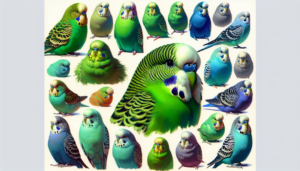Exploring The Colorful World of Budgie Mutations
 The Science Behind Parakeet Color Mutations
The Science Behind Parakeet Color Mutations
Parakeets, or budgerigars, are well known for their rainbow of feather colors. While most people admire these variations for their beauty, the explanation for how they occur lies in fascinating science. Every shade, from bright greens and blues to rare violets and albinos, is the result of genetic mutations that affect pigments, feather structures, and how color is inherited.
In the wild, budgerigars are naturally green and yellow. This classic appearance is the “wild type” that offers camouflage in Australia’s grasslands. The green we see is actually a combination of two factors: a yellow pigment called psittacofulvin and a structural blue created by the way light reflects off microscopic feather cells. When the yellow pigment overlays the structural blue, the result is the familiar green. Mutations work by changing one or both of these elements, which is why we see so many different colors in domesticated parakeets.
For example, if a mutation removes the yellow pigment while leaving the structural blue, the bird appears blue instead of green. If melanin (the dark pigment responsible for markings and shading) is missing, a bird may appear albino, with pure white feathers and red eyes, or lutino, with yellow feathers and red eyes. Other mutations, such as cinnamon, lighten the melanin to a soft brown, while spangle alters the wing feather patterns to create a shimmering effect.
The way these mutations are inherited depends on genetics. Some are dominant, meaning a chick only needs one parent carrying the mutation to show it. Others are recessive, requiring both parents to pass on the gene before the trait becomes visible. Certain mutations, like lutino and cinnamon, are sex-linked, meaning they are carried on the sex chromosomes and expressed differently in males and females. These genetic pathways explain why some colors are easy to produce while others remain rare.
Beyond the familiar colors, there are also advanced combinations. Violet mutations intensify blue shades into striking purple hues, while grey mutations introduce slate tones into green or blue birds. Breeders often combine multiple mutations, carefully tracking which genes are dominant, recessive, or sex-linked to predict the outcome. This makes parakeet breeding not just an art but also a science, where each pairing has a genetic formula behind it.
For the average parakeet owner, understanding this science adds a new layer of appreciation. Every budgie’s appearance tells a story of pigments, structural colors, and inheritance patterns. When you look at your parakeet—whether it’s green, blue, pied, cinnamon, or albino—you’re seeing the result of generations of selective breeding and the intricate science of genetics.
If you’d like to explore the wide spectrum of colors themselves, make sure to visit our Parakeet Colors page, where the visual side of these genetic stories comes to life.

 The Science Behind Parakeet Color Mutations
The Science Behind Parakeet Color Mutations